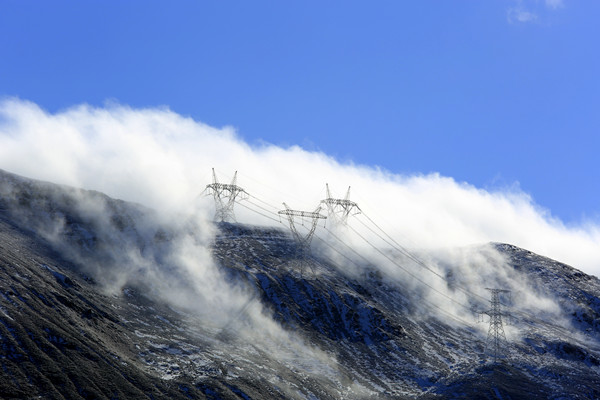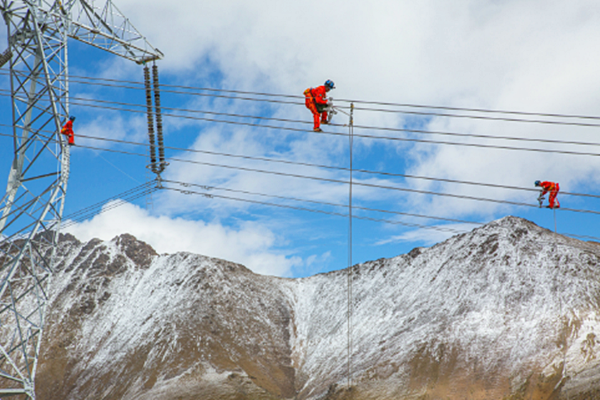World's hardest power grid project operates in Tibet
A completion ceremony for a central Tibet power grid interconnection project was held on Nov 23, 2018. The construction was approved in March 2017 and started on April 6, 2017.
Undertaken by State Grid Construction of China (State Grid), the project includes two parts, namely the central Tibet-Changdu Grid Interconnection Project and the Lhasa-Nyingchi Power Supply Project for the Sichuan-Tibet Railway. It stretches from Markham county, Chamdo city, to Sangri county, Lhokha city, spanning ten Tibetan counties in three cities.

The power transmission towers for the central Tibet power grid interconnection project [Photo/sasac.gov.cn]
The total investment of the project was 16.2 billion yuan ($2.33 billion), accounting for 50 percent of Tibetan power gird's fixed assets.
The project built sixteen 500 kV-power transformation stations and 500 kV circuits over a distance of 2,738 km.
It is the most complicated and challenging extra-high-voltage power transmission and transformation project in the world.
The average altitude of the grid construction is over 4,000 m. The project's highest power transmission tower sits at 5,295 m; it is also the world's highest 5,00 kV power transmission tower. The 500 kV power transformation station in Markham county is 4,295 m above sea level, the world's highest such station.

Technologists are working on the power transmission towers for the central Tibet power grid interconnection project [Photo/sasac.gov.cn]
Over 500 million people from 81 companies and institutions were involved in the project construction.
They faced an extreme working environment as the power grid goes through Hengduan mountains, the Qinghai-Tibet Plateau, and the Lancang River, Nujiang River and Yarlung Zangbo River areas, which are windy and extremely cold, lack oxygen, and have intense radiation as well as dangerous animals.
The complicated natural conditions could easily cause plateau-related diseases such as pulmonary and cerebral edema.
In addition to the risk of disease another problem was transportation of materials. Total transport volume was over one million tons and the heaviest materials that had to be moved at one time weighted 140 tons. The average haul distance was 1,200 km and the longest was 5,900 km.

A power transformation station of the central Tibet power grid interconnection project [Photo/sasac.gov.cn]
Road conditions were a hurdle material transportation had to overcome. Rugged roads, frequently damaged by natural disasters, meant materials had to be transported to construction sites by cable and sometimes even by hinnies and horses.
The local vulnerable natural environment included 10 national protected areas required scrupulous attention to construction of power grid interconnection.
Although there were all these diverse challenges to the project, it was completed successfully.

The central Tibet power grid interconnection project [Photo/sasac.gov.cn]
The interconnection project links central Tibet power grid with China's main grids, improving local voltage classes from 220 kV to 500 kV and satisfying the huge electricity demand of developing cities and counties in Tibet such as Lhasa, Shigatse city, Lhokha city, Nyingchi city and Nagchu prefecture. About 1.56 million residents in 3,070 towns affected by the project can now access reliable electricity. In addition, the power support will drive more investments to Tibet and help increase its employment, revenues and economy.
The project can not only transmit power to the autonomous region, but can also channel clean power outside of Tibet to support the national clean energy strategy. Tibet is China's important hydrogen power base with a huge power potential of 140 million kW and its solar and wind power are rich enough to make a large-scale photovoltaic power station and wind power plant feasible.
The power grid interconnection project now can transmit 400-thousand-kW of electricity, which is expected to improve to millions of kW. Tibet's clean energy has a convenient nationwide channel.

Technologists are working on the power transmission towers for the central Tibet power grid interconnection project [Photo/sasac.gov.cn]
Actually, the project is not the only one that the State Grid has undertaken in Tibet. During China's 12th five-year-plan period (2011-2015), the company invested 27.3 billion yuan in the region for building and coordinating power grids, bringing power to hundreds and thousands of households. The great efforts broke the region's power shortage and supported local economic development.
State Grid has decided to further improve power grid investments in Tibet from 2018 to 2020. It will put 72.4 billion yuan into the Tibet autonomous region as well as Sichuan, Gansu and Qinghai provinces for power grids development and realize grid interconnection in those regions.
(Executive editor: Hao Wen)



